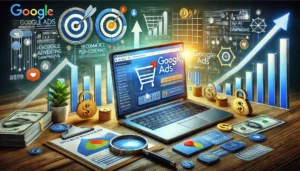The eCommerce Growth Equation: Are You Missing a Piece?

The world of eCommerce is always changing, and businesses need to keep up to succeed. From understanding market trends to using the latest technology, every piece of the puzzle matters. This article will guide you through the key elements that drive eCommerce growth and help you identify any missing pieces in your strategy.
Key Takeaways
- eCommerce is growing fast, and businesses need to stay updated with market trends.
- Digital marketing, including SEO, social media, and email, plays a big role in eCommerce success.
- A well-designed, mobile-friendly, and fast website is crucial for customer satisfaction.
- Data analytics can provide valuable insights into customer behaviour and help improve your strategies.
- Using paid advertising wisely can expand your reach and boost sales.
Understanding the eCommerce Growth Landscape
Historical Trends and Future Projections
We’ve seen eCommerce grow rapidly over the past decade. From small online shops to massive marketplaces, the landscape has changed dramatically. Future projections suggest even more growth, with technology and consumer behaviour driving this trend.
Key Drivers of eCommerce Growth
Several factors contribute to the rise of eCommerce. These include technological advancements, increased internet access, and changing consumer preferences. We must also consider the role of mobile devices and social media in shaping shopping habits.
Challenges in the Current Market (The eCommerce Growth Equation)
Despite the growth, there are challenges. Competition is fierce, and customer expectations are higher than ever. Additionally, issues like cybersecurity and logistics can pose significant hurdles. We need to stay ahead by continuously innovating and adapting to market changes.
The Role of Digital Marketing in eCommerce Growth
Importance of SEO and Content Marketing
In the world of eCommerce, SEO and content marketing are crucial. They help us get noticed by search engines and attract more visitors. Good SEO practises ensure our site ranks higher, making it easier for customers to find us. Content marketing, on the other hand, keeps them engaged and coming back for more.
Leveraging Social Media for Brand Awareness
Social media platforms are powerful tools for building brand awareness. We can reach a large audience quickly and interact with them directly. By sharing engaging content and responding to comments, we create a community around our brand. This not only boosts our visibility but also builds trust with our customers.
Email Marketing Strategies for Customer Retention (The eCommerce Growth Equation)
Email marketing is a great way to keep our customers informed and engaged. By sending personalised emails, we can offer special deals and updates that keep our customers coming back. It’s a direct line of communication that helps us build strong relationships with our audience.
Digital marketing is not just about attracting new customers; it’s about building lasting relationships with them.
In summary, digital marketing plays a vital role in the growth of our eCommerce business. From SEO and content marketing to social media and email campaigns, each strategy helps us reach and retain our customers effectively.
Optimising Your eCommerce Website for Growth
User Experience and Interface Design
We all know that first impressions matter. When customers visit our site, they should find it easy to navigate and visually appealing. A well-designed interface can make a huge difference. We should focus on intuitive layouts, clear calls to action, and a seamless checkout process. This not only keeps visitors on our site longer but also encourages them to make a purchase.
Mobile Optimisation and Responsiveness
In today’s world, many people shop on their phones. If our website isn’t mobile-friendly, we’re missing out on a lot of potential sales. We need to ensure that our site is responsive and looks great on all devices. This means testing on various screen sizes and making adjustments as needed. A mobile-optimised site can significantly boost our conversion rates.
Site Speed and Performance
Nobody likes a slow website. If our pages take too long to load, visitors will leave before they even see what we have to offer. We should regularly check our site’s speed and make improvements where necessary. This could involve compressing images, using a content delivery network (CDN), or optimising our code. A fast website not only improves user experience but also helps with our search engine rankings.
By focusing on these key areas, we can create a website that not only attracts visitors but also converts them into loyal customers. Let’s not overlook the importance of a well-optimised site in our eCommerce growth strategy.
The eCommerce Growth Equation: Harnessing the Power of Data Analytics
Tracking Key Performance Indicators
To grow our eCommerce business, we need to keep an eye on key performance indicators (KPIs). These metrics help us understand how well our strategies are working. Sales conversion rate is one of the most important KPIs. It tells us how many visitors are turning into customers. Another crucial metric is the average order value, which shows how much customers spend on average per order. By tracking these KPIs, we can make informed decisions and adjust our strategies as needed.
Customer Behaviour Analysis (The eCommerce Growth Equation)
Understanding customer behaviour is essential for any eCommerce business. We can use tools like Google Analytics to see how customers interact with our site. This data helps us identify which pages are most popular and where customers drop off. By analysing this information, we can improve the user experience and increase sales. For example, if we notice that many customers abandon their carts, we can implement strategies to reduce cart abandonment.
Utilising A/B Testing for Continuous Improvement
A/B testing is a powerful method for improving our eCommerce site. By testing different versions of a webpage, we can see which one performs better. This helps us make data-driven decisions and continuously improve our site. For instance, we can test different headlines, images, or call-to-action buttons to see which ones lead to more conversions. A/B testing allows us to optimise our site based on real data, rather than guesswork.
Data analytics is not just about collecting data; it’s about using that data to make better decisions and drive growth.
By harnessing the power of data analytics, we can gain valuable insights into our business and make informed decisions that drive growth. Whether it’s tracking KPIs, analysing customer behaviour, or utilising A/B testing, data analytics is a crucial tool for any eCommerce business.
The eCommerce Growth Equation: Effective Use of Paid Advertising
Google Ads and Pay-Per-Click Campaigns
When it comes to driving traffic and sales, Google Ads is a powerful tool. We can create targeted campaigns that reach the right audience at the right time. A thorough Google ads audit helps us identify areas for improvement and optimise our campaigns for better performance. By working with a reputable PPC ad agency, we can ensure our ads are effective and cost-efficient.
Social Media Advertising (The eCommerce Growth Equation)
Social media platforms like Facebook, Instagram, and Twitter offer unique opportunities for paid advertising. We can leverage these platforms to increase brand awareness and drive traffic to our eCommerce site. However, it’s crucial to stay updated with the latest trends and regulations, such as the ongoing debate about EU data regulations. Partnering with experienced Google ads agencies can help us navigate these complexities.
Retargeting Strategies
Retargeting is an essential strategy for converting visitors who have shown interest in our products but haven’t made a purchase. By using Google AdWords PPC and other retargeting tools, we can remind potential customers of our offerings and encourage them to complete their purchase. A well-executed retargeting campaign can significantly boost our conversion rates and overall sales.
The eCommerce Growth Equation: Expanding Your Reach
International Market Penetration
Expanding into international markets can be a game-changer for our eCommerce business. We need to understand local cultures, preferences, and regulations. This means translating our website, localising our products, and offering local payment options. Understanding local markets is crucial for success.
Multi-Channel Selling Strategies (The eCommerce Growth Equation)
Selling on multiple channels helps us reach more customers. We can use platforms like Amazon, eBay, and social media to sell our products. Each platform has its own audience and rules. By diversifying our sales channels, we reduce risk and increase our chances of success.
Partnerships and Collaborations
Partnering with other businesses can help us grow faster. We can collaborate with influencers, other brands, or even a PPC ecommerce agency. These partnerships can help us reach new audiences and build trust. Working together makes us stronger and more competitive.
Expanding our eCommerce reach requires a strategic approach. By understanding local markets, diversifying our sales channels, and forming strong partnerships, we can achieve sustainable growth.
The eCommerce Growth Equation: Building a Strong Brand Identity
Creating a Unique Value Proposition
We need to start by defining what makes our brand special. A unique value proposition (UVP) sets us apart from the competition. It tells customers why they should choose us over others. Our UVP should be clear and compelling. It should highlight the benefits and solutions we offer. This is the foundation of our brand identity.
Consistent Brand Messaging (The eCommerce Growth Equation)
Consistency is key in branding. Our message should be the same across all channels. This includes our website, social media, and advertisements. Consistent messaging builds trust and recognition. It helps customers remember us. We should use the same tone, style, and voice everywhere.
Customer Reviews and Testimonials
Customer reviews are powerful. They show real experiences and build trust. We should encourage satisfied customers to leave reviews. Testimonials can be featured on our website and social media. They act as proof of our quality and reliability. Positive feedback can greatly influence potential customers.
Building a strong brand identity is not just about logos and colours. It’s about creating a lasting impression and a relationship with our customers.
The eCommerce Growth Equation: Customer Service Excellence
Implementing Live Chat and Chatbots
In today’s fast-paced world, customers expect quick responses. Implementing live chat and chatbots on our eCommerce site can significantly improve customer satisfaction. These tools provide instant support, answering common questions and resolving issues in real-time. Live chat can handle multiple queries simultaneously, reducing wait times and enhancing the overall shopping experience.
Personalised Customer Support (The eCommerce Growth Equation)
Personalised customer support is key to building strong relationships with our customers. By using data analytics, we can tailor our responses to meet individual needs. This approach not only makes customers feel valued but also increases their loyalty to our brand. We should train our support team to use customer data effectively, ensuring every interaction is meaningful and relevant.
Handling Returns and Complaints Effectively
Handling returns and complaints effectively is crucial for maintaining customer trust. A clear and simple returns policy can make a big difference. We need to ensure that our process is hassle-free and transparent. When dealing with complaints, it’s important to listen actively and offer solutions promptly. This not only resolves the issue but also turns a negative experience into a positive one.
Excellent customer service is not just about solving problems; it’s about creating a seamless and enjoyable shopping experience for our customers.
The eCommerce Growth Equation: Sustainable Practises in eCommerce
Eco-Friendly Packaging Solutions
We all know that packaging plays a huge role in eCommerce. By switching to eco-friendly packaging, we can reduce our environmental impact. Using recyclable materials and biodegradable options can make a big difference. Let’s consider using less plastic and more sustainable materials like paper or cardboard.
Ethical Sourcing and Supply Chain Management (The eCommerce Growth Equation)
Ethical sourcing is crucial for building trust with our customers. We need to ensure that our products are sourced responsibly. This means working with suppliers who follow fair labour practises and environmental standards. By doing this, we not only help the planet but also improve our brand’s reputation.
Promoting Sustainability to Customers
Promoting sustainability isn’t just about what we do; it’s also about educating our customers. We can share tips on how they can be more eco-friendly. For example, we can encourage them to recycle packaging or choose products with a lower carbon footprint. Highlighting our sustainable efforts can also attract more eco-conscious customers.
Sustainability is not just a trend; it’s a responsibility we all share. By adopting sustainable practises, we can make a positive impact on the environment and our business.
Let’s work together to make our eCommerce business more sustainable and set an example for others to follow.
The eCommerce Growth Equation: Leveraging Emerging Technologies
Artificial Intelligence and Machine Learning
Artificial Intelligence (AI) and Machine Learning (ML) are transforming the eCommerce landscape. We can use AI to personalise customer experiences, making product recommendations based on past behaviour. ML helps in predicting trends and automating inventory management. AI-driven chatbots can also provide instant customer support, enhancing user satisfaction.
Augmented Reality for Product Visualisation (The eCommerce Growth Equation)
Augmented Reality (AR) allows customers to visualise products in their own space before making a purchase. This technology reduces return rates and increases customer confidence. Imagine trying out furniture in your living room or seeing how a dress fits without leaving your home. AR is a game-changer for online shopping.
Blockchain for Secure Transactions
Blockchain technology ensures secure and transparent transactions. It can be used to track the entire supply chain, from production to delivery. This not only builds trust but also reduces fraud. With blockchain, we can offer our customers a more secure shopping experience, making them feel more confident in their purchases.
The eCommerce Growth Equation: Financial Management for eCommerce Businesses
Budgeting and Forecasting
We need to start with a solid budget. This helps us plan our spending and avoid surprises. Forecasting is also key. It lets us predict future sales and expenses. Accurate forecasting can make or break our business.
Managing Cash Flow (The eCommerce Growth Equation)
Cash flow is the lifeblood of any business. We must keep track of money coming in and going out. This helps us avoid running out of cash. A simple table can help us monitor our cash flow:
| Month | Income | Expenses | Net Cash Flow |
|---|---|---|---|
| Jan | £10,000 | £8,000 | £2,000 |
| Feb | £12,000 | £9,000 | £3,000 |
| Mar | £11,000 | £10,000 | £1,000 |
Investment in Growth Opportunities
Investing in growth is crucial. We should look for opportunities that offer the best returns. This could be new products, marketing campaigns, or technology upgrades. Smart investments can help us stay ahead of the competition.
Effective financial management is not just about cutting costs. It’s about making the right investments to grow our business.
Managing finances for an eCommerce business can be tricky, but it’s crucial for success. From budgeting to tracking expenses, every step matters. Want to learn more? Visit our website for expert advice and tips!
Conclusion
In the fast-paced world of eCommerce, every piece of the puzzle matters. From understanding your audience to optimising your product listings, each step plays a crucial role in your success. If you find that your growth has stalled, it might be time to re-evaluate your strategies. Remember, even small changes can lead to significant improvements. Keep learning, stay adaptable, and don’t be afraid to seek expert advice when needed. Your eCommerce journey is a marathon, not a sprint, and with the right approach, you can achieve lasting success.
Frequently Asked Questions
What are the main drivers of eCommerce growth?
The main drivers include increased internet access, mobile device usage, and the convenience of online shopping. Social media and digital marketing also play big roles.
Why is SEO important for eCommerce?
SEO helps your website rank higher on search engines, making it easier for customers to find your products. This can lead to more traffic and sales.
How can social media help my eCommerce business?
Social media can increase brand awareness, engage customers, and drive traffic to your website. It’s also a great way to get customer feedback and build community.
What is the role of data analytics in eCommerce?
Data analytics helps you understand customer behaviour, track key performance indicators, and make informed decisions. It can also show you what’s working and what’s not.
How can I improve my website’s user experience?
Focus on easy navigation, fast loading times, and mobile optimisation. Make sure your site is user-friendly and visually appealing.
What are the benefits of email marketing?
Email marketing helps you retain customers by keeping them informed about new products, sales, and updates. It’s a cost-effective way to drive repeat business.
Why should I consider international markets for my eCommerce business?
Expanding to international markets can increase your customer base and sales. It also helps diversify your revenue streams and reduce dependency on a single market.
What are some sustainable practises in eCommerce?
Using eco-friendly packaging, ethical sourcing, and promoting sustainability to customers are some ways to make your eCommerce business more sustainable.
Author
Search Blog
Free PPC Audit
Subscribe to our Newsletter
The Voices of Our Success: Your Words, Our Pride
Don't just take our word for it. With over 100+ five-star reviews, we let our work-and our satisfied clients-speak for us.
"We have been working with PPC Geeks for around 6 months and have found Mark and the team to be very impressive. Having worked with a few companies in this and similar sectors, I rate PPC Geeks as the strongest I have come across. They have taken time to understand our business, our market and competitors and supported us to devise a strategy to generate business. I value the expertise Mark and his team provide and trust them to make the best recommendations for the long-term."
~ Just Go, Alasdair Anderson




